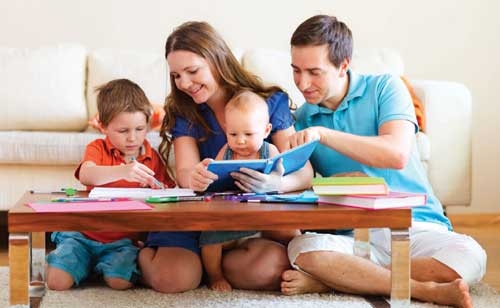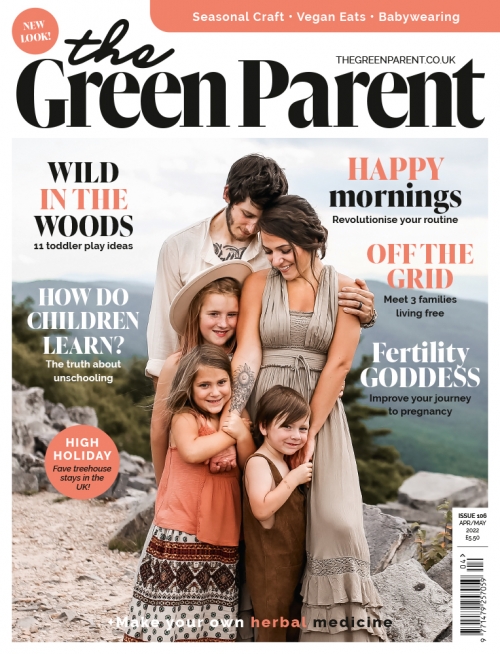Every Friday afternoon a group of home educating parents meets up at our local park for a chat and craft session whilst the children play. It started when a forward-thinking friend of mine brought paper and pencils along for those children who didn’t feel like swinging or climbing. The adults ambushed the art equipment. Soon a piece of group art was being passed round the table with each of us adding to the picture. The week after, crochet hooks were brandished, sketchbooks materialised and our crafternoon sessions were born.
For me, craft is a link to my female lineage; my grandmother was a dressmaker, who made clothes for my sister and I and taught me to sew and my mum created with us continuously. I don’t think the kitchen table was ever clear from pots of glue, paints, fabric and all the wonderful treasures we found whilst out walking. Making things together was so much fun and I want to share that precious legacy with my own children. As, it seems, do many others.
Freedom of expression
At home in Lincolnshire, Pippa Dore has five children and believes that art helps her children to express themselves. “I always have craft equipment on hand for the children, it makes a bit of a mess, but I think it’s really important that they can express themselves freely. At the moment, there are Halloween masks in various stages of production around the house and glitter in all the wrong places!!”
Mildred Mascheder, educator and grandparent shares Pippa’s opinion, “I feel imaginative play and the arts are invaluable to simulate a child’s imagination. To provide a child with enormous inner resources of creativity for their whole life, offering tactile materials, i.e. clay, paints, water, sand and earth feeds the imagination and the senses.”
Natural born creators
Often parents find that their children help to reawaken an interest in crafts. Children are naturally creative and they are very adept at helping us to find this again in ourselves. Mary Willis, mother of three, says “I rediscovered handicrafts when my babies were small. Knitting and crocheting were something I could do whilst breastfeeding. It was soothing and meditative and my baby got lovingly knitted, if a little misshapen, clothes made from organic yarn.” Jane Thornberger also found art through her children, “My eldest has always been very expressive. He loves painting and drawing, usually on a large scale. Recently it became a family activity – to make art together on a Sunday evening and it has given us a wonderful focus for family time and helped me remember how much I enjoy creating things.”
“Sewing or knitting is a great way to find peace in motherhood, whilst still being there for our children.”
Early motherhood can be challenging and demanding, physically and emotionally. Young children need us to be part of their world, to be constantly present for them. Certain crafts lend themselves well to being present whilst finding a little solace in the midst of a busy day. Sewing or knitting is a great way to find peace in motherhood, whilst still being there for our children. Jill Jones, mother of one says, “My daughter won’t let me use the computer or read a book during the day but she’s quite happy for me to finish a sewing project or do some crocheting.”
Letting go
Brought up in today’s results driven society it can be difficult to let go and encourage our children (and ourselves) to enjoy the process of creating without concern for the final product. Mascheder feels that it is important that we learn to do this however. “We can honour and respect whatever a child creates rather than seeming to assess or judge it. Even praise fulsomely bestowed can be a mixed blessing as these are adult standards. The child can be left with a feeling that she could not manage such a success again or she can sense that this offering is unworthy of such praise.” Mascheder recommends adopting the art therapist’s approach instead and encouraging dialogue with the creator about what they are feeling and expressing through their work.
Many of us who grew up with the feeling that we are no good at art can find a real joy in letting go of our fears and expectations and just enjoying the creative process. Pippa Dore considered herself useless at sewing after experiences at school but bolstered by a few early successes and approval from friends she has since got past her anxieties and started making things again. “It’s given me huge satisfaction to be able to make clothes for my children. They aren’t perfect by any means, but it’s such a confidence boost to sit down and make clothes that keep them warm and comfy at the time that they need them. It was a friend that I met through the Green Parent forum who gave me the final push to get my sewing machine out and have a go.”
Better parent
Many crafters find that making things helps them access their inner parenting skills. Amanda Blake Soule, mother of four, crafter and author began knitting whilst pregnant as it helped her to calm down and connect with her baby. “By the time my first child was born, I realised my newly found creativity was too important to lose. I began to notice that when I was able to fit a bit of creating into my day, I was more centred, at peace and fulfilled. All these things made me a calmer, more patient and more mindful parent. My needs were getting met and I was therefore able to meet the needs of my children even better.”

Creating time
So we know that it is important for us and our children to be creatively involved. But how can we manage this alongside all the other family commitments? It’s easy to get swept up in the busyness of everyday life, the washing, cleaning and cooking that come with running a home. However, Soule believes that it is our responsibility to make time for crafts. “Life details often stand in the way of the time we need to pursue our creative endeavours. As parents it’s both our responsibility and our privilege to be sure that our family’s creative spirits have all the room and tools they need to soar freely.” Fitting it in needn’t be too much of a struggle. Integrating art into family life can be fun and easy and tailored to suit your family’s needs and time available. Five minutes of drawing a day is a good place to start and family interest can grow from there. Soule holds a daily drawing session with her four unschooled children during the winter months. “Keep a special notebook for each person just for Family Drawing Time. Children find it special to have something just for the occasion and I think many adults would agree. Drawing books, journals – they’re just fun, aren’t they?” Claire Simmonds also makes time every day for a project. “Most mornings, my three-year-old, Bella and I go for a walk. We collect natural objects and take them home to draw, make things with or to decorate the nature table. This act of creativity and the connectedness it helps me feel with the natural world have ensured that I have kept my cool during times of stress.” If you don’t have time for a walk followed by an art session, there are many other ways to express creativity – singing, dancing, cooking, gardening and even cleaning are all acts of creation. Enjoy exploring the possibilities with your family. So what of Friday afternoons in the park? There’s talk of a group quilting session during the winter months and the children are becoming interested in what we are up to too. Some of us have started carrying a sketchbook and pencils everywhere we go. I got mine out in the glasshouse at Wisley Gardens in Surrey recently and I think I might have inspired a few people to stop and take a closer look at the plants around them in a different way. Well, maybe. And so the passion for creating things spreads in its organic way.
TIPS FOR GETTING CRAFTY
• Buy the best quality art equipment you can afford
• Display the art your family create – on the fridge, framed on the wall or use it for cards and wrapping paper (with your child’s approval)
• Use nature for inspiration – follow the seasons with your creativity – hand dyed eggs in spring, leaf rubbing in autumn, for example.
• Make space for art – even if it’s just one end of the kitchen table, keep as much equipment to hand as possible so that you can all get creative when the mood strikes.
Further reading
Living Out Loud: An Activity Book to Fuel a Creative Life by Keri Smith
The Creative Journal for Children by Lucia Capacchione
Ecoart! Lauri Carlson
Earthwise by Carol Petrash






